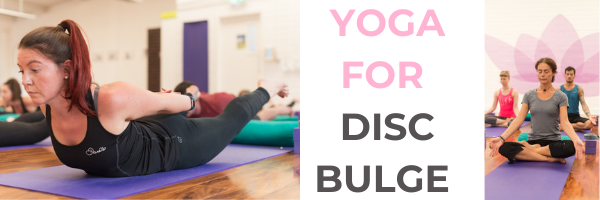Yoga for Disc Bulge & Protrusion

Yoga for Disc Bulges and Protrusions
This week we got a question from a student about starting yoga with disc bulges. We know that this is an issue with many of our clients and we wanted to share our thoughts on this issue.
“Hi there- I just found out I have 2 disc bulges in my lower back, my doctor has suggested yoga, is there anything I should know before I start a class?“
David, Dublin
It’s great that David’s GP suggested yoga, and we are delighted that he wrote to us so we could guide him.
While we are always pleased to hear that doctors are referring their clients to holistic therapeutic practices such as yoga to manage these issues, there are some precautions that we should take when starting yoga when we have disc bulges.
Yoga is extremely therapeutic for disc bulges specifically for Lumbar Disc Protrusions.
Disc protrusions cause instability in the spine and as ligaments cannot be strengthened with yoga (or any exercise) we want to strengthen the muscles around the spine to counteract this lack of stability. Yoga also nourishes and aids the healing of the spine by bringing fresh blood flow to this area. And when we improve our posture and core strength with yoga we can reduce pain or future bulges from occurring
While yoga is a wonderful tool to aid recovery, a general flow class may not be appropriate without the proper modifications applied.
Before we get to the yoga, what is a disc bulge?
A disc bulge refers to an extension or prolapse of disc tissues beyond the edges of the edge of vertebrae. In some cases, this bulge can press on the nerve causing mild or severe pain depending on severity.
Around 30% of the population have disc bulges, and we want to prevent them from progressing to fully herniated discs which can cause a host of issues such as lower back pain, sciatica, and even complete immobility due to pain in some extreme cases.
The issue with attending a general spectrum yoga class, especially without your teacher being informed about your disc bulges is that any forward folding (flexion) could exasperate a bulge.
Now, there are yoga Asana (poses) that are extremely helpful for disc protrusion, however, they should be done in isolation, not in a general class that also includes a forward fold.
Any deep flexion, especially with a rounded back, could potentially turn your bulge into a full prolapse.
Guidelines for practicing safely with a disc bulge
- Avoid forward folds or flexion if possible, bend knees
- If you do incorporate them into your practice, ensure you keep your chin forward and avoid rounding your spine, when we round our spine, and forward fold at the same time it pushes the prolapsed disc further towards the edge of the vertebrae
How Yoga Can Help
If we look at the issue of forward folds (flexion) bringing the disc further towards the edge of the vertebrae, we can see how backbends, or extension of the spine would do the opposite- bring the disc back towards the other side of the spine (where it should be!)
With this in mind here is a sequence you can practice daily to aid recovery from
Morning time
5 x sphinx pose, held for 5 breaths followed by 5 baby cobra or full cobra held for 5 breaths.
1 x Setu Bandhansana held for 10 breaths (you can use a foam yoga block to support your lower back here)
From Setu Bandhasana bring one with both knees bent and feet planted on the floor bring place your hands behind one and bring it towards your chest until you feel a slight pull. Hold this for 15 seconds and do both sides.
Evening Time
5 x Setu Bandhasana held for 5 breaths (you can use a foam yoga block to support your lower back here)
From Setu Bandhasana bring one with both knees bent and feet planted on the floor bring place your hands behind one and bring it towards your chest until you feel a slight pull. Hold this for 15 seconds and do both sides.
Attending a Yoga Class
If you do attend a yoga class, remember the principle for avoiding or modifying your forward folds and keep your knees bent where possible- and most importantly, let your yoga teacher know so they can keep you safe with modifications.
Off the mat
Don’t just apply these principles to yoga. When you get off your mat and head home to do the housework, take care of your family, or finally clean out the garage- the same principles apply. Avoid forward folding to avoid placing unnecessary pressure on the anterior portion of the disc.
Remember, always get medical clearance from your doctor, listen closely to your body, and avoid anything that causes you pain.
Do you have any questions for us about this topic? What about another issue you are facing around injury, accessibility, or anything related to your practise
Drop them in the comments- we love to hear from you!